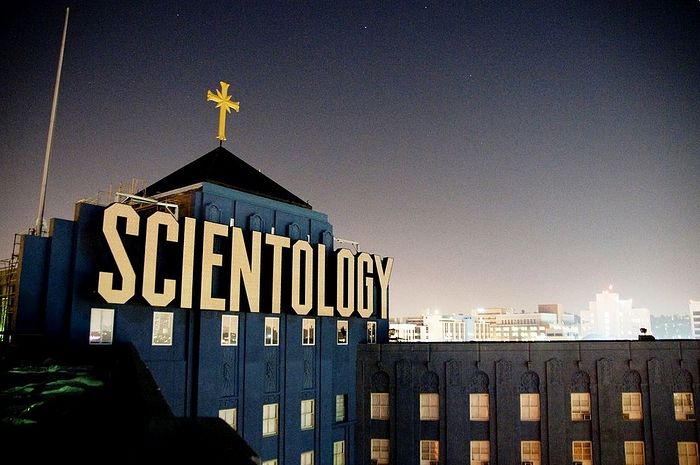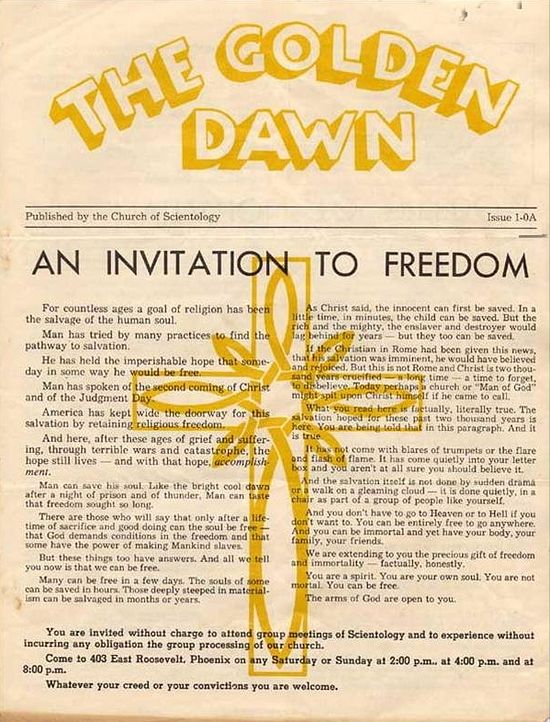This presentation was read by Aleksandr Leonidovich Dvorkin, president of the Ireneaus of Lyons Center for Religious Research Studies, on January 26th, 2016, at a conference run by the Orthodox St. Tikhon University for the Humanities. (Translator’s note: While we wouldn’t claim that the Church of Scientology is an integral element of the US Intelligence Community, Dvorkin’s lecture is an excellent expose of the nexus between the Western power structure, its intelligence apparatus and dangerous cults).
The topic of Scientology’s connection to the CIA became commonplace long ago. It’s mentioned in a mass of articles, interviews, and television programs. But when I referred to this in passing during a conversation with one journalist several months ago, he took interest: do I have irrefutable evidence of or clues to this connection? Could I, so to say, point to a “smoking gun?”
The question interested me, and I decided to try and collect materials on this topic. So can we bring irrefutable evidence?
It’s understandable that if I could point to a “smoking gun,” my name would be Edward Snowden, and I would be hunted by US intelligence services, who (like any intelligence services) never disclose the names of organizations that cooperate with them, and for obvious reasons. However, open information on when the US government began to openly and publicly lobby the interests of Scientology (this occurred in 1993) could compose an entire arsenal of smoking guns. It knew full well about the cult’s activity in legally and illegally collecting information on various people and organizations.
From documents published today, we know that already in 1957 the CIA began investigating the activities of L. Ron Hubbard and Scientology. But the collated data that was the result of the investigation has still not been published up to this time. I don’t think we should expect the publication of these materials in the near future.
All his life, Hubbard himself was quite actively and constantly fascinated with two things: occultism and intelligence activities. For example, as a still wholly young man he entered the Rosicrucian order, undertook occult séances, and experienced certain otherworldly meetings.
 Aleister Crowley, head of the Ordo Templi Orientis (OTO) and the most well-known Satanist of the twentieth century. Crowley was also a British intelligence asset.
Aleister Crowley, head of the Ordo Templi Orientis (OTO) and the most well-known Satanist of the twentieth century. Crowley was also a British intelligence asset.
Already as head of the Scientology cult, with pride he called Aleister Crowley, the most famous Satanist of the twentieth century, his “very good friend.” We can bring a multitude of other facts, but that wouldn’t fit into the parameters of the current presentation. I’ll remind you that John Atack’s excellent article “Hubbard and Occultism” was published in my Russian translation.[1]
Scientology’s official biography of the cult’s founder furiously denies Hubbard’s ties to occultism, but then it exaggerates his special relationship with the intelligence services on a cosmic scale. And so with pride the Scientologists inform us that during the war Hubbard worked in the US Office of Naval Intelligence (ONI), where he heroically proved himself in “catching foreign spies and rendering aid to US forces surrounded by the enemy on the island of Bataan.” As a matter of fact, we know that while working in ONI, Hubbard was just a rank-and-file clerk in the mail department, where he mainly censored the correspondence of servicemen—there’s certainly nothing heroic in that. Not once during the entire war did he take part in combat action.
Scientologists also invented the legend justifying Hubbard’s postwar time in the Pasadena lodge of the Satanic Ordo Templi Orientis (the “Order of the Eastern Temple” headed by Crowley) and his fascination with sex magic rituals, which he conducted together with lodge head Jack Parsons. According to the cult’s legend, Hubbard, you see, was sent into the Satanic cult by a certain intelligence agency as a mole and destroyed it from within. There is no need to speak about this version not withstanding factual criticism.
Hubbard’s enthusiasm for occultism also left its mark in the symbols of Scientology he and his followers developed.
Here, for example, is a Scientology flyer published during Hubbard’s life, called “The Golden Dawn” (so was called the occult lodge whence came Aleister Crowley).
Here is a contemporary audio and video publication of Hubbard’s works, also called “The Golden Dawn.”
And here’s what a speech by the current head of Scientology, David Miscavige, looks like. The occult symbology of a previously thought-out stage interior doesn’t need any clarification. Temple columns, the theme of “Golden Dawn and the Moon (an extremely widespread occult symbol) over the “high priest.”


Here is the Scientology cross well-known to all, borrowed from the deck of Tarot cards developed by Crowley. I’ll remind you that this is in fact a crossed-out cross. Also pay attention to another detail: the eight-pointed star, on which is set the image of the cross. We’ll come back to it again.

Now we will note that there is something in common between Scientology founder L. Ron Hubbard and the US Intelligence Community—a passion for occultism.
For a start, here are a few facts:
In 1989 in London former CIA officer Miles Copeland’s memoirs, The Game Player, were released, in which he told of a scheme set into action during the early-mid 1950s by his colleague Bob Mandelstam. The scheme was called “Occultism in High Places.” Its idea was simple: since some leaders and heads of governments had the habit of consulting with astrologers and other occult advisors, American intelligence officers were to “work with” these occultists and make them conduits of their agency’s influence.
This scheme worked, for example, when a “clairvoyant” sent by the agents convinced Ghana’s President Kwame Nkrumah to make a visit to China, during which a coup inspired by the CIA overthrew the absent leader. In Copeland’s words, the US intelligence community influenced Indonesian President Sukarno “quite solidly” through occult “seers” and “fortune tellers.”
Mandelstam also used the spiritual-political movement “Moral Rearmament,” which, according to Copeland, gave agents the opportunity to influence not only African and Asian political figures through secret channels, but also European leaders. It is there that Copeland also mentions a special agreement, which, in his words, the CIA concluded with Scientology, although he is silent about what was contained therein. Inasmuch as I was able to find out, no one aside from the chatty Copeland mentions this agreement (clearly established in the 1960’s) in open sources.
Copeland tells of another interesting case:
We sent into the Scientology cult our agent, who under the direction of Ron Hubbard himself became “clear,” but then he demanded and started to receive ever more “monetary compensation for operational expenditures,” which together with his savings he gave over to Dianetics.[2]
So we will hardly find out who was ultimately manipulating whom: the CIA Scientology, or Scientology the CIA.
In the same way the work of US intelligence officers with a variety of occultists hasn’t gone unnoticed: we can presume that influence disseminated to both sides, and someone among the intelligence officers began practicing occultism. The set of images used by the secret services gives certain bases for making such presumptions concrete.
Here is the emblem of the United States Intelligence Community:

We see the same eight-pointed star, just like the one placed on the Scientology cross. Let’s return to the image of the Scientology cross. Its crossing out can also be viewed as the union of four daggers. And so the daggers cross out the symbol of Christianity. But the dagger is a famous symbol of intelligence, and precisely the star of the Intelligence Community is composed of them.
In the center of the Intelligence Community’s star is a rose with five petals. But this—the five-petaled rose—is the symbol of the Rosicrucian order. Is that a coincidence? Hardly: after all, even the image of the sharp leaflets between the petals is repeated.
And then there’s the most interesting thing: we’ll read the description of the seal that is found on the official site of the US Office of the Director of National Intelligence.
The eight points of the polar star symbolize the six departments and two independent agencies of the Intelligence Community. They are combined with the 15 stars around the circumference [sic] represent the elements of other agencies that are also part of the Intelligence Community.[3]
The problem is that there aren’t 15 stars. There are 16. Count them yourself. So what then is the unnamed sixteenth organization, an element of which is part of the US Intelligence Community? Can we build suppositions?
Now we will finally bring some circumstantial evidence that can easily be found in open sources.
At the beginning of the 1990’s, the Greek police executed raids in the Athens Scientology office and confiscated a multitude of the cult’s internal documents, a part of which were published. In some of them are contained references to assistance that the CIA rendered to Scientology’s foreign branches.
 Scientology internal document on CIA cooperation, confiscated by Greek police.
Scientology internal document on CIA cooperation, confiscated by Greek police.
Already in 2001 in the magazine Le Monde Diplomatique was published an article by the famous journalist Bruno Fuscero “Cults: a US Trojan Horse for Europe,”[4] in which he quite reasonably wrote on the use of a whole set of cults, including Scientology, by US intelligence and diplomacy. Despite the sensational character of the article, no lawsuits followed after it.
Hardly anyone can deny that the US State Department lobbies the interests of Scientology in various countries: France; Germany; Italy; Greece; Russia; Hungary, etc. Even among the published Wikileaks documents, a report slipped by that after US Secretary of State Madeleine Albright’s arrival in Germany, German Scientologists were invited to the US Embassy for a briefing. Inasmuch as I know, no other cult enjoys such attention and such privileges from the United States government. I also understand that nothing is given for free in this world. So what can Scientology offer the US government that the latter would so actively lobby the interests of a comparatively not large cult with far from the most spotless reputation, and whose secret doctrine the whole world laughs at?
One of Scientology’s main objectives is the collection and storage of a large mass of information, so that with its help it can compromise and establish control over whomever: from a simple member of the cult who has gone astray to the powerful of this world, control of whom would give unlimited possibilities. Twenty-five years ago the former head of the FBI’s Los Angeles Field Office said that Scientology “has one of the most effective intelligence services, which can even compete with the FBI.” From that time the cult’s capital has increased several times over, if not exponentially. It can afford to hire many more lawyers and private detectives, which significantly raises the cult’s potential for carrying out complex special operations.
Now a little history: In 1993, after a twenty-five-year war it waged against Scientology, the US Internal Revenue Service de facto surrendered: having conducted secret negotiations with cult head David Miscavige, it signed an agreement with the group, according to which it recognized Scientology and all related organizations a religion and totally freed them from taxes. Namely after this agreement the State Department began to lobby Scientology’s interests in all the world’s countries. Moreover, a secret protocol was attached to the agreement (a new one, not the one mentioned by Copeland), and it hasn’t been published to this day. What could the content be?
Ukrainian Prime Minister Arseny Yatseniuk (who many years ago, as director of Aval Bank in Kiev, possibly underwent several Scientology courses) is an example of a man about whom personal information would be extremely interesting not only to Scientology, but also to the US Intelligence Community. I think that we could continue a list of people occupying high posts in various countries, people who are of interest to US intelligence, for a sufficiently long time. And if Scientology has such information and is ready to share it, then why wouldn’t an intelligence service use such an opportunity?
Yet in what way can the cult obtain such data? Scientology’s information collection is generated through several methods.
 Are we having fun yet? Tell all your most intimate secrets to the E-Meter; it’s strictly confidential! Author William S. Burroughs, pedophile, occultist and suspected CIA asset had plenty of blackmail material handy.
Are we having fun yet? Tell all your most intimate secrets to the E-Meter; it’s strictly confidential! Author William S. Burroughs, pedophile, occultist and suspected CIA asset had plenty of blackmail material handy.
The first of them is auditing, presented by the cult as a kind of confession. But during this “confession,” everything that a person—in a state of light hypnotic trance—might report over a three-to-four hour session is picked up on audio and video and kept forever (I’ll remind you that this is conducted with the help of the so-called “E-Meter,” i.e. a primitive lie detector). Those who conduct the auditing are not obliged to keep the secrets of this “confession.” Rather, they collect the most intimate information about a person in order to turn him into an obedient slave. Let’s recall that during a raid of the Taganskaya Scientology “Ideal Org” by Moscow law enforcement, spy equipment for audio and video recording was found built into the walls of the auditing room. By the standards of the cult, such equipment should be present in all auditing facilities.
The second method is the “targeted” collection of information on a person who interests the cult. Specialists are hired for this, and specially instructed cult members help them. Either compromising materials are found, or they are fabricated. Among those who interest the cult could be famous personalities; figures in show business; law enforcement; officers of the security services; political figures; and of course, enemies of the cult.
We can and must emphasize that both methods of collecting and using information are flagrantly amoral. The cult uses the obtained data for self-advancement and self-expansion. I wonder, has it ever crossed the minds of American intelligence officers that receiving such information from the cult and using it is deeply amoral? Scientologists themselves think that the opportunity to control people in such a way serves a higher goal that brings the cult’s victory closer, meaning the victory of “good” in all the world. But if US intelligence, in no way believing in Scientology’s good and progressivism, finds it necessary and permissible to use this information, then we need to honestly admit that it considers getting information acquired by a quite dubious organization through deceit, bribery, theft, torture, and confidential confessions normal.
Finally, even if we believe that Scientology has absolutely no ties with any of the agencies of the US Intelligence Community, it could still absolutely and unmistakably be called a foreign intelligence organization active in the Russian Federation. And this intelligence organization sends personal and deeply confidential data on Russian citizens to its headquarters in the United States. That means we must approach such an organization in corresponding fashion.
But of course, it seems to me that we can claim with an enormous degree of confidence that Scientology has a multitude of connections with the US Intelligence Community. The evidence I’ve brought forth in this presentation, quite weighty if circumstantial, indicates precisely that. Almost two years ago, US President Barack Obama publicly announced that international religious freedom (read: its American version) is a vital factor of US national security.[5] I think that this announcement, striking in its cynical frankness, only admitted what had been an obvious fact for years. And we can probably suppose which organization hides behind the unnamed sixteenth star on the US Intelligence Community’s coat of arms.
English translation originally appeared at the Espionage History Archive





